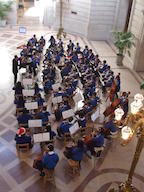Introduction
Visual and performing arts classes at APG are designed to provide a comprehensive and sequential instruction. Arts Department courses are aligned with the California Visual and Performing Arts Standards. We celebrate the arts in our powerfully creative and artistically diverse community, to encourage students to view themselves as life-long-learners who are inspired by the arts and act as creative participants in our school community. We offer Band, Choir, Dance, Digital Media, Drama, Guitar, Orchestra, and Visual Arts.
6th Grade Arts Choices Link to this section
What is band? Link to this section
We like to tell the students that band is the instruments you blow into. although this is not completely true, it is an easy way to compare band and orchestra.
Band is an instrumental ensemble made up of the following instruments: Flute, Clarinet, Oboe, Bassoon, Saxophone, Trumpet, French Horn, Trombone, Baritone, Tuba, and Percussion.
What is orchestra? Link to this section
We like to tell the students that "orchestra has instruments with strings." Orchestra is an instrumental ensemble made up of the following instruments: Violin, Viola, Bass, and Cello.
What is the Unified Arts Rotation? Link to this section
We now have a quarterly rotation for 6th-grade arts: media, drama, visual arts, and choir.
Please Note Link to this section
The 6th grade is the last time students are able to enroll in Orchestra, Dance, and Band.
Message to Incoming 6th graders Link to this section
We are so excited to work with you over the next three years. A.P. Giannini Middle School has a history of excellence in the Arts Department. All Art classes are sequential, standards-based courses taught by exemplary teachers.
We now have a quarterly rotation for 6th-grade arts: media, drama, visual arts, and choir as well as year-long offerings of band, orchestra, or dance. Please note that 6th grade is the last time students can enroll in the band or orchestra programs.
In 7th and 8th grade, the students continue in either band or orchestra or choose a class from a wide variety of courses including art, choir, creative writing drama, drama tech, film, or guitar.
No matter which arts class a student chooses to pursue, parents can be assured it is a high-quality program. The band, choir, and orchestra perform throughout the Bay Area participating in many festivals, competitions, and concerts. The drama program puts on two full productions each year. Media students enter their films in National film festivals and students showcase their films in the end-of-the-year Media Night. Take a stroll around the school to witness the plethora of art created by our young artists.
Differences between Elementary and Middle School in the Arts Department Link to this section
 The Arts Department in middle school differs from elementary school in a number of ways. In elementary school, the musicians do not always meet daily nor receive a grade specifically for the class.
The Arts Department in middle school differs from elementary school in a number of ways. In elementary school, the musicians do not always meet daily nor receive a grade specifically for the class.
In middle school, the arts classes are just that: classes. This means the students meet everyday, receive a grade, and will probably need to work outside of class-time to master the concepts and skills presented in class.
Also, no experience is necessary! We have plenty of supplies and instruments to give your child the tools to succeed in any class. If your child wants to play an instrument but never has before, we will not only teach your child but also provide an instrument they may use.
The Arts Dept Teachers' Emails Link to this section
- Ms. Allison: allisons@sfusd.edu (Art)
- Ms. Carbonara: carbonaram@sfusd.edu (Dance)
- Ms. Dinan: dinand@sfusd.edu (Choir)
- Mr. Ferraris: ferrarisp@sfusd.edu (Media)
- Mr. Gabaldon: gabaldonj@sfusd.edu (Computer Science and Media)
- Mr. Gushiken: gushikenk@sfusd.edu (Band and Guitar)
- Mr. Heidtman: heidtmanr@sfusd.edu (Orchestra)
- Ms. Rivera: riveram3@sfusd.edu (Dance) [on maternity leave SY25-26]
- Ms. Sunderland: sunderlandj@sfusd.edu (Drama)
This page was last updated on August 15, 2025

